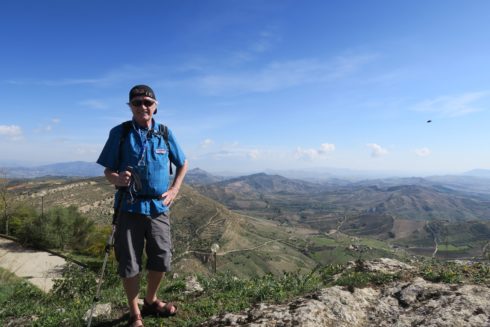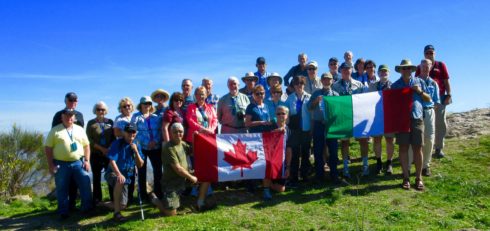Mount Assoro – An Unrecognized Canadian Victory
It’s the second day of Liberation Tours 2016 tour of Canadian battlefield sites in Sicily and we’re in our bus heading from Catania to the scene of some of the fiercest fighting to take place on that fabled island. The land we are passing through today is much richer and more prosperous looking than that of southeast Italy that we visited yesterday. Mount Etna rises abruptly on our right and is the dominant geographical feature in all of central and northeast Sicily. There is a thin plume of smoke rising from its still active volcanic crest and reminds me that to the ancient Greeks this mountain was the home of the deformed god Hephaestus, cuckolded husband of Aphrodite. They believed the smoke emanated from Hephaestus’ workshop where he produced armour for the likes of Hercules and Achilles. A few years back Alison and I climbed to the top of Mount Etna which you can reach from a chairlift that goes almost to the summit. It is a very eerie feeling walking over ground that is very hot while the air, at almost 11,000 feet, is decidedly chilly. Today we are headed for a lesser, although equally deadly, summit – Mount Assoro.
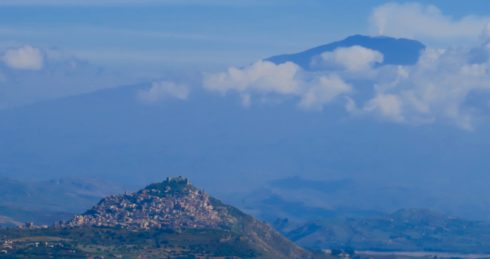
Piazza Amerina & Valguanera
In the last post I described the Canadian’s liberation of the town of Pachino and their subsequent drive northward and the first encounter with German troops at Grammichele. Post Grammichele, the Canadians continued north where the Three Rivers Tank Regiment and the Loyal Edmonton Regiment earned the second Canadian Battle Honour at Piazza Armerina, taking the historic town and a great amount of valuable supplies on July 17. Although we did not visit the town on this trip, Alison and I were here a few years ago to visit the UNESCO World Heritage site of Villa Romana del Casale which has some of the most famously preserved Roman mosaics to be found anywhere. At that time, I had no idea that the place was liberated by Canadians and in particular, young Albertan boys, many of whom died here.
After Piazza Amerina, the Canadians fought their first divisional battle of the entire war at Valguanera. You can see from the map below that the Canadian forces represented by the solid red line, crossed through the American forces in green and the British forces in dashed red, to lead the attack on Valguanera. By now the Allies knew that the German tactics consisted of setting up defensible fortified positions from which they could inflict as much damage as possible before retreating to the next fortified position. In fact, this was the story of the entire Italian campaign. There was nothing for it, but to attack these positions and kill as many Germans as possible while losing as little men as we could and the Canadians demonstrated an unwavering ability to accomplish just that. For example, the Hasty Ps launched an eventually unsuccessful attack on Valguanera suffering twenty casualties, but in turn killing up to ninety Germans and wounding many more. In another, six German trucks carrying reinforcements were attacked by one man, Alex Campbell, who charged at them with a Bren gun, holding a spare clip in his teeth. When his stunned compatriots realized that he was going to an almost certain death, they all opened fire and it was a German slaughterhouse.
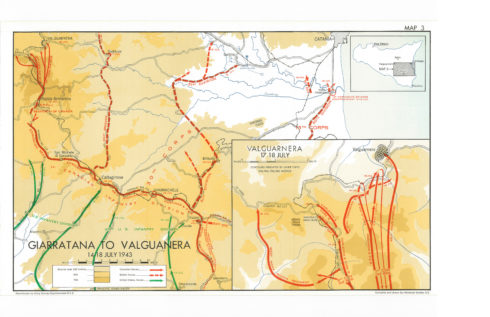
The following regiments received Battle Honours at Valguanera – Three Rivers Tank Regiment, Saskatoon Light Infantry, Royal Canadian Regiment, Hastings and Prince Edward, 48th Highlanders, Van Doos, Carleton & Yorks and the Southwest Novas. By now, pretty well all the Canadian troops who landed in Sicily on July 10th had seen hot action and were rapidly becoming veterans, but they paid a heavy price at Valguamera – over 40 men killed and over another 100 wounded. Yet, the toughest nuts to crack lay straight ahead, Mount Assoro and the towns of Leonforte and Nissoria.
From this map you can see just how much progress the Canadians had made in such a short period of time. They we were well over half way to the joint objective of Messina where the Allies hoped to prevent the German forces from escaping to the mainland. However, from the yellow dots, you can see that the number of fortified German positions was greatly increasing.
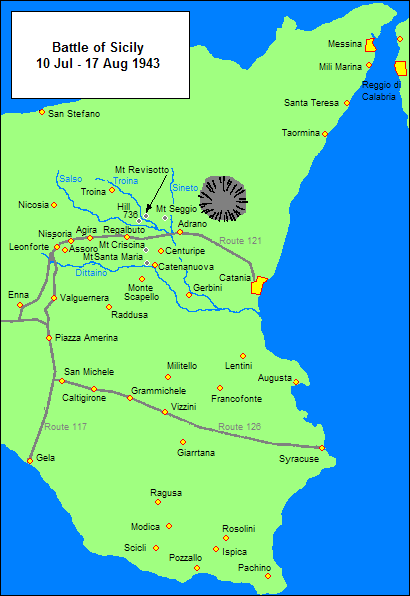
As we head up the Dittaino River valley from Catania, I can’t help but notice that this is a beautiful landscape with ancient towns on almost all of the hill tops. They would be wonderful places in which just to wander the cobblestone streets and maybe enjoy an espresso (if that’s not an oxymoron) or perhaps a glass of the local white wine while watching Mount Etna in the distance. I’m awoken from this reverie by the sight of Mount Assoro and the town which clings to its summit.
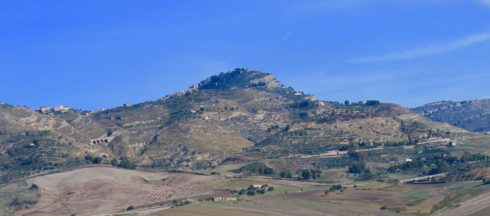
Mount Assoro
Technically, Mount Assoro is what is known as a cuesta, a Spanish word for a hill that has a gentle slope on one side and a steep face on the other. You are looking at the gentle side in this picture. The Canadians arrived here on August 19th and battalion commanders began the process of figuring out just how to capture the town of Assoro and more importantly, the artillery and soldiers that were sitting on the very top of Mount Assoro. They learned very quickly and tragically of just how deadly those positions were when the Hasty Ps commanding officer Lt. Col. Bruce Albert Sutcliffe and his intelligence officer, were both killed instantly by a shell fired from Mount Assoro, over four miles away. He was posthumously awarded the Distinguished Service Order.
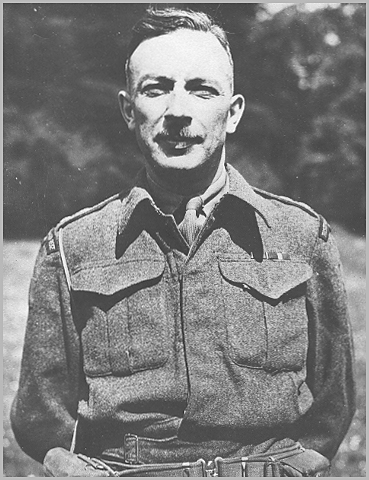
Clearly any type of assault on Mount Assoro from the gentle sloping side was impossible, even at night. The only possibility, and it seemed ludicrously slim, was to try to climb the 1000 foot cliffside slope at night and surprise the Germans. As we turn off the main highway and start the ascent of Mount Assoro through one hairpin turn after another, going higher and higher, the idea of actually climbing it at night is beyond my comprehension. But climb it the Canadians did, and we are about to see just what a monumental feat of courage and resolution that truly was.
Assoro
The town of Assoro was founded way back around 1000 B.C. by the ancient Siculi people for whom the island of Sicily is named. Although not on any regular tourist routes, it has a number of important historical sites including the remains of a castle attributed to the great Norman/Sicilian King Robert II and the cathedral of San Leone. We’ll see the castle as we reach the summit of Mount Assoro. The bus can make it only so far into the town before we have to park and make our way up a flight of stairs to a stone-paved walkway that leads to the top.
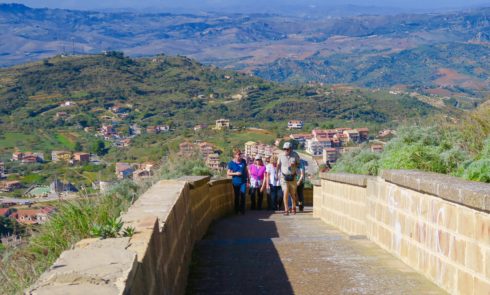
It’s fairly easy going, but still gets the heart pounding before arriving at the top from which there are fantastic views. That’s the town of Assoro below.
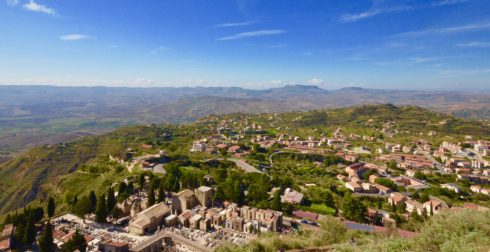
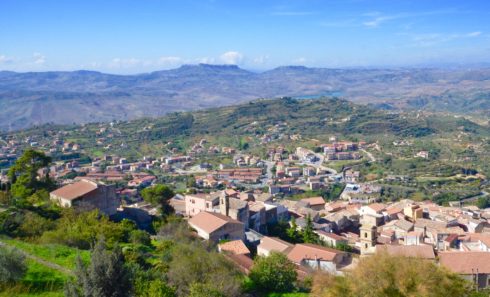
That’s a portion of the town of Leonforte below, which was also an objective for the Canadian forces at the same time as they assaulted Mount Assoro.
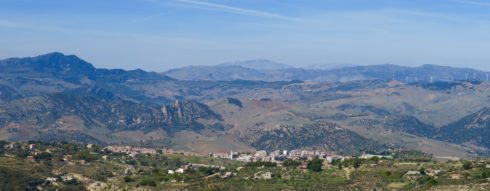
And here’s what’s left of Robert’s castle – not much.
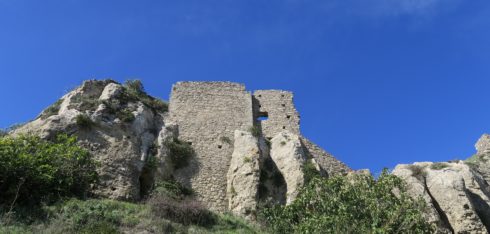
After the last stragglers arrive on top, our tour historian Mark Zuehlke, who wrote the book Operation Husky, which describes the Canadian campaign in Sicily, and our historical interpreter Phil Craig, who brings incredible life to his readings from Farley Mowat’s books The Regiment and And No Birds Sang, tell us the story of the taking of Mount Assoro.
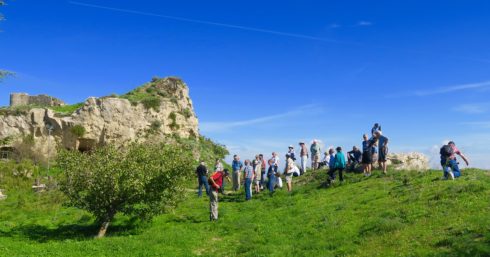
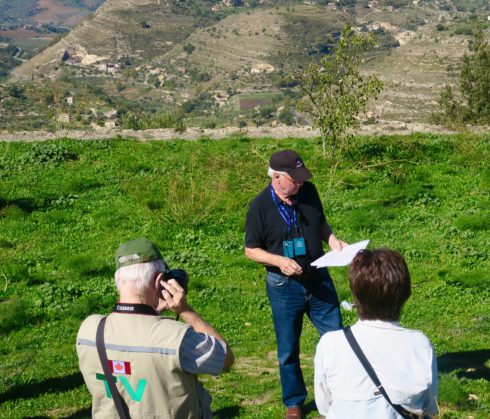
Here’s a map that will help you to understand just what a feat it was. Mount Assoro is 980 metres high, the highest point for miles around. If you can get up there you can fire down at the German positions on the sloping side of the hill, as well as the defenders of Leonforte and the batteries guarding the main east/west road on Sicily.
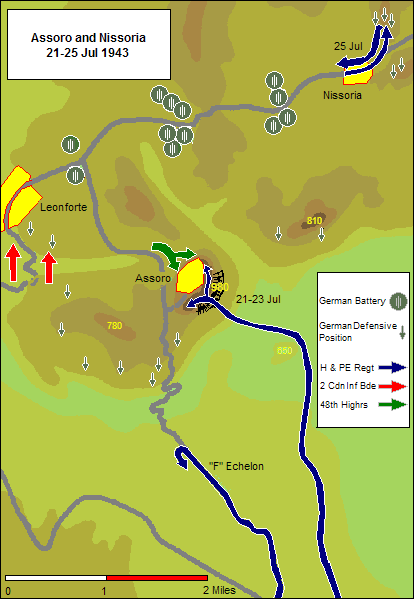
The only problem is that the only way to get up there is to scale a 1,000 foot cliff and standing at the top today that just seems impossible, even in daylight.
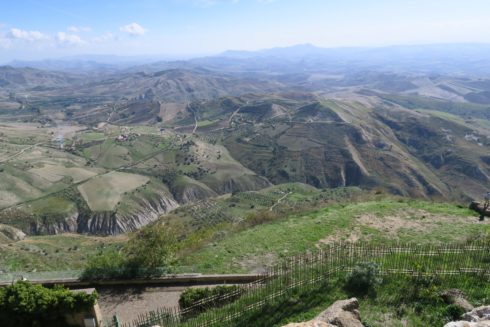
Here’s another view. Remember, the Canadians were starting from the bottom of that huge gully, the edge of which you can just make out. Trust me, it’s a lot steeper looking than these photographs portray.
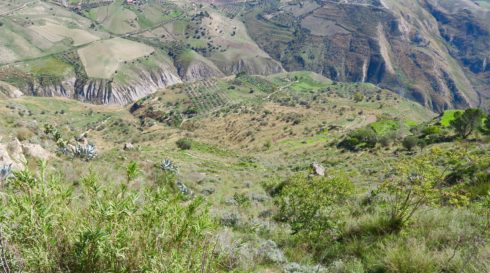
The assignment to climb Mount Assoro in the dark was given to the Hasty Ps (Hastings and Prince Edward Regiment) and led by none other than the same Major Alex Campbell who had wreaked such havoc on the German troop convoy at Valguanera. Volunteers were called for and many answered the call. They stripped down to only their necessary arms and ammunition and set out at dusk on what I consider to be one of the greatest achievements in Canadian military history.
As school children we all learned about General Wolfe’s climbing of the cliffs of Quebec at night with his men to arrive on the Plains of Abraham where a stunned French army went down to defeat. The difference between that climb and this one is that Wolfe had a guide (supposedly, although some accounts deny it) and the cliffs were nowhere near as high, although in parts they might have been steeper. We’re talking a few hundred feet at most versus a thousand.
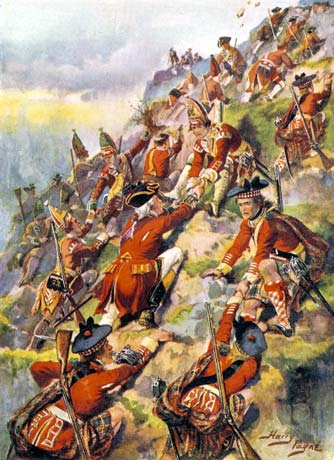
I had no trouble finding this painting of Wolfe’s admittedly illustrious climb, but try to find anything commemorating the Hasty Ps climb up Mount Assoro and you’ll draw a blank. But climb it they did, without any light and without making any noise to alert the garrison at the top. Total surprise was achieved and the Germans were overpowered, killed or captured. We didn’t lose a single man. But that wasn’t the end. The Germans poured heavy shell fire into the newly acquired position and the Hasty Ps could do nothing but wait for reinforcements. Some managed to find shelter in several caves at the top.
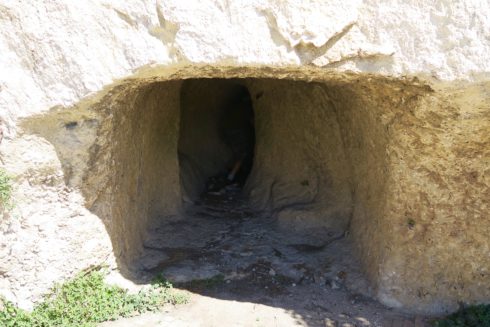
Eventually, a day and a half later, relief arrived in the form of the RCRs (Royal Canadian Regiment) and the Hasty Ps, out of food and water, exhausted beyond belief, were at last able to realize the tremendous tactical victory they had secured at Mount Assoro. Being here in person, and hearing the story told by Mark and Phil, our group was simply mesmerized by the greatest Canadian war story never told.
Afterwords we gathered at a number of monuments that do mark the achievements of those days.
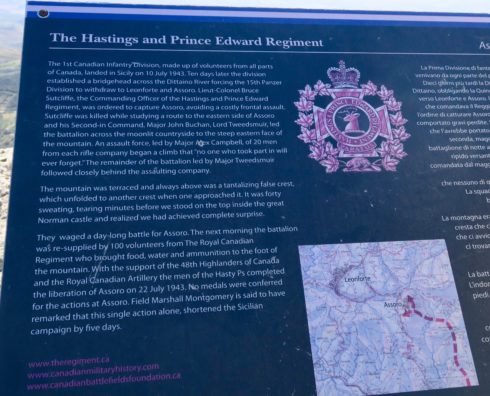
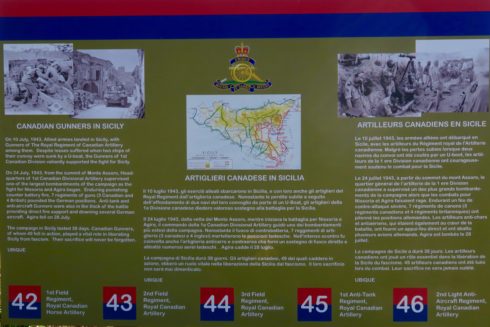
We ended our visit to Mount Assoro by placing two Canadian flags at what might have been the very spot where one of the Hasty Ps first crested the hill on the morning of July 20, 1943 and then placing a photograph of one of the men who was here on that day. It was the least that we could do.
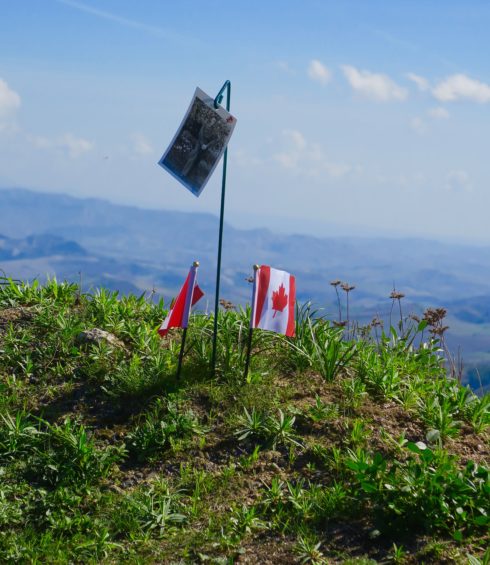
The Hasty Ps and the 48th Highlanders earned Battle Honours at Mount Assoro, but incredibly, not one man received a commendation. Apparently there’s a back story to that, but this post is long enough already.
So that’s the story of Mount Assoro. Next we are on the the town of Nissoria where further fierce fighting ensued and then our first visit to a Commonwealth War Cemetery on this tour. Won’t you join us?
